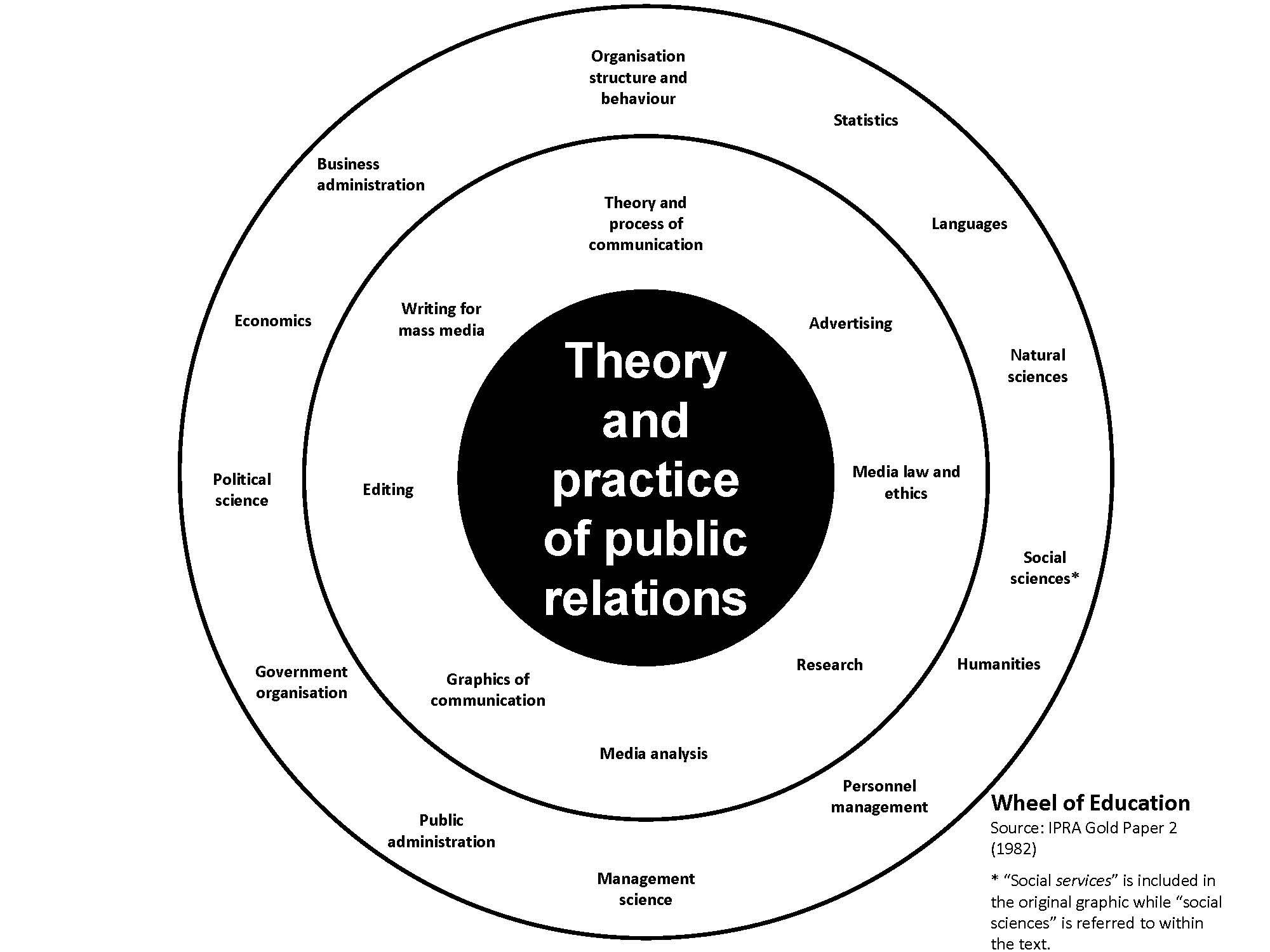
The 1982 gold paper credits the Wheel model to the IPRA World of Public Relations Exhibition held in London in 1979. The model has been described1 as an invention of Sam Black, an influential British public relations practitioner, who was active in the IPRA and played an important part in developing public relations education2. The Wheel graphic is presented at the beginning of the 1982 gold paper and is explained in detail in an appendix. The model builds on the Commission on Public Relations Education3 concentric circle approach to public relations education.
The Wheel model has three components:
Outer circle – A liberal arts foundation:
-Organisation structure and behaviour
-Statistics
-Languages
-Natural sciences
-Social services
-Humanities
-Personnel management
-Management science
-Public administration
-Government organisation
-Political science
-Economics
-Business administration
Middle circle – Communication studies:
-Theory and process of communication
-Advertising
-Media law and ethics
-Research
-Media analysis
-Graphics of communication
-Editing
-Writing for mass media
Inner central circle – Public relations:
-Theory and practice of public relations
During my conference presentation I mentioned an apparent discrepancy: the graphic includes “social services” in the middle circle, but the appendix refers to a different concept, “social sciences”. Luckily, the audience included a conference participant who was involved in the preparation of the 1982 gold paper and recalled the debate amongst IPRA education and research committee members over the term “social sciences”. Some of the committee abhorred that term; so “social services” was used in the graphic as a compromise.
The Wheel model was produced by an international team of educators and practitioners over three decades ago. To what extent is the model relevant to public relations education today?
What do you think?
- Are there elements of the model that you feel are relevant today?
- What is it lacking?
- To what extent do we need to re-invent this 1970s wheel?
Editor’s Note: The original IPRA gold papers from 1982 and 1990 that featured The Wheel of Education model are not available online to our knowledge. But reproductions of the papers are available at the following links: 1982 Gold Paper and 1990 Gold Paper.
Dr Mary Welch is a senior lecturer in communication management at the Lancashire Business School at the University of Central Lancashire in the United Kingdom.
1 Janssen, G. (1985). PR Education at Universities. In Denig, E., van der Meiden, A. (Eds.) (1985) A Geography of Public Relations Trends: Selected Proceedings of the 10th Public Relations World Congress “Between People and Power”. Amsterdam, Springer.
2 Sharpe, M., B. J.deSanto (2005) Sam Black. In R. Heath (Ed.) (2005) Encyclopedia of public relations (pp. 439-442). Thousand Oaks. Sage.
3 CPRE (1975) A design for public relations education. Public Relations Review Vol. 1 No. 3 pp. 56-66.





there is bright future on public relations for that you need to search for Top 10 public relations agencies in Australia , india, uk and more where ever you stay.
Even though the general “Business Administration” is represented in the outer circle, I believe Marketing needs to be placed in the middle circle as both Advertising and Marketing (along with Public Relations) play important roles in Integrated Marketing Communications, which most public relations students will be expected to embrace as practitioners.